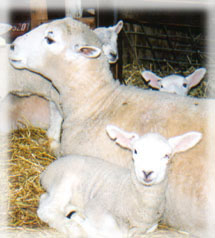Q fever primary prevention
|
Q fever Microchapters |
|
Diagnosis |
|---|
|
Treatment |
|
Case Studies |
|
Q fever primary prevention On the Web |
|
American Roentgen Ray Society Images of Q fever primary prevention |
|
Risk calculators and risk factors for Q fever primary prevention |
Editor-In-Chief: C. Michael Gibson, M.S., M.D. [1];Associate Editor(s)-in-Chief: Ahmed Younes M.B.B.CH [2]
Prevention

In the United States, Q fever outbreaks have resulted mainly from occupational exposure involving veterinarians, meat processing plant workers, sheep and dairy workers, livestock farmers, and researchers at facilities housing sheep. Prevention and control efforts should be directed primarily toward these groups and environments.
The following measures should be used in the prevention and control of Q fever:
- Educate the public on sources of infection.
- Appropriately dispose of placenta, birth products, fetal membranes, and aborted fetuses at facilities housing sheep and goats.
- Restrict access to barns and laboratories used in housing potentially infected animals.
- Use only pasteurized milk and milk products.
- Use appropriate procedures for bagging, autoclaving, and washing of laboratory clothing.
- Vaccinate (where possible) individuals engaged in research with pregnant sheep or live C. burnetii.
- Quarantine imported animals.
- Ensure that holding facilities for sheep should be located away from populated areas. Animals should be routinely tested for antibodies to C. burnetii, and measures should be implemented to prevent airflow to other occupied areas.
- Counsel persons at highest risk for developing chronic Q fever, especially persons with pre-existing cardiac valvular disease or individuals with vascular grafts.
A vaccine for Q fever has been developed and has successfully protected humans in occupational settings in Australia. However, this vaccine is not commercially available in the United States. Persons wishing to be vaccinated should first have a skin and blood test to determine a history of previous exposure. Individuals who have previously been exposed to C. burnetii should not receive the vaccine because severe reactions, localized to the area of the injected vaccine, may occur. After a single dose of vaccine, protective immunity lasts for many years and revaccination is not generally required. Annual screening is typically recommended.[3] A vaccine for use in animals has also been developed, but it is not available in the United States.
Q fever is effectively prevented by intradermal vaccination using a vaccine composed of killed Coxiella burnetii organisms. A skin and blood test, prior to vaccination must be undertaken in order to establish whether there is pre-existing immunity, as vaccination of immune subjects can result in a severe local reaction. In 2001, Australia introduced a national Q fever vaccination program for people working in "at risk" occupations.
Because of its route of infection it can be used as biological warfare agent. See also bioterrorism.Q-fever is category "B" agent. It is highly contagious and very stable in aerosols in a wide range of temperatures. Just 1-2 particles are enough to infect an individual. Q-fever microorganisms may survive on surfaces up to 60 days (like sporulating bacteria) and C. burnetii is known to reproduce and grow well in chicken egg embryos reaching very high concentrations. Protection against disease is offered by Q-Vax, a whole cell inactivated vaccine developed by a leading Australian vaccine manufacturing company CSL.